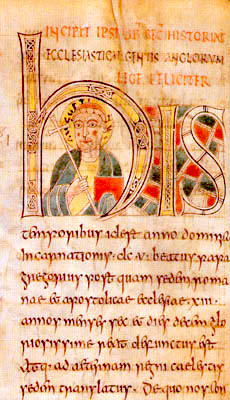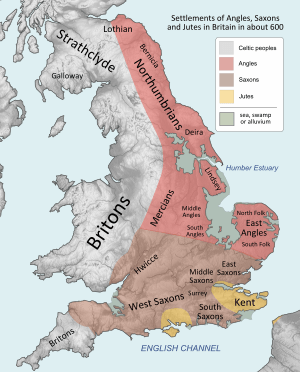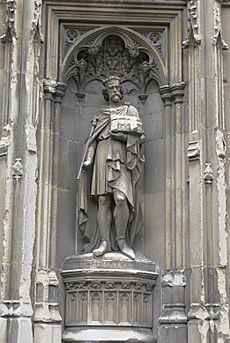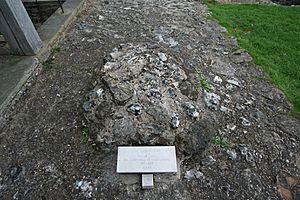Augustine of Canterbury facts for kids
Quick facts for kids Saint Augustine |
|
|---|---|
| Archbishop of Canterbury | |

Portrait labelled "AUGUSTINUS" from the mid-8th century Saint Petersburg Bede, though perhaps intended as Gregory the Great.
|
|
| Diocese | Canterbury |
| See | Canterbury |
| Appointed | before 601 |
| Reign ended | probably 26 May 604 |
| Predecessor | none |
| Successor | Laurence of Canterbury |
| Other posts | Prior of Abbey of St Andrew's |
| Orders | |
| Consecration | c. 597 |
| Personal details | |
| Born | early 6th century, probably in Italy |
| Died | probably 26 May 604 Canterbury, Kent, England |
| Buried | St Augustine's Abbey, Canterbury |
| Sainthood | |
| Feast day |
26 May (Anglican, Eastern Orthodox, and Catholic Extraordinary Form calendar in Great Britain)
27 May (Catholic Ordinary Form calendar) 28 May (Catholic Extraordinary Form calendar outside Great Britain) |
| Venerated in | |
| Canonized | Pre-Congregation |
| Shrines | |
Augustine of Canterbury (born in the early 500s – died around 604) was a monk who became the first Archbishop of Canterbury in 597. He is known as the "Apostle to the English." He helped bring Christianity to England and is seen as a founder of the English Church.
Augustine was a leader at a monastery in Rome. In 595, Pope Gregory the Great chose him to lead a special mission. This mission, called the Gregorian mission, was to go to Britain. Its goal was to teach Christianity to King Æthelberht and his people in the Kingdom of Kent.
Kent was likely chosen because King Æthelberht's wife, Bertha, was a Christian princess. She was the daughter of Charibert I, a king of Paris. It was hoped she would help convince her husband to become Christian. Before reaching Kent, Augustine and his group thought about turning back. But Pope Gregory encouraged them to continue. In 597, Augustine landed on the Isle of Thanet and traveled to Canterbury, King Æthelberht's main town.
King Æthelberht soon became a Christian. He allowed the missionaries to preach freely. He also gave them land to build a monastery outside the city walls. Augustine became a bishop and converted many people. Thousands were baptized on Christmas Day in 597. Pope Gregory sent more missionaries in 601 with helpful letters and gifts. Augustine also set up new bishoprics in London and Rochester in 604. He started a school to train Anglo-Saxon priests. Augustine also made sure his successor, Laurence of Canterbury, was chosen before he died. Augustine likely passed away in 604 and was later honored as a saint.
Contents
Why the Mission Started
After the Roman armies left Britain in 410, the people had to defend themselves. They faced attacks from the Saxons. Before the Romans left, Christianity was present in Britain. But after they left, pagan tribes settled in the southern parts of the island. Western Britain, however, remained Christian.
This native British Church grew separately from Rome. It was influenced by missionaries from Ireland. Its churches were often centered around monasteries, not just bishops. There were also differences in how they calculated Easter and the haircut (tonsure) their priests wore. There is no clear sign that these native Christians tried to convert the Anglo-Saxons. The invasions destroyed much of the Roman way of life in the areas the Saxons took over.
Because of this, Pope Gregory I decided to send a mission in 595. He wanted to convert the Anglo-Saxons to Christianity. The Kingdom of Kent was ruled by King Æthelberht. He had married a Christian princess named Bertha before 588. Bertha was a Frankish princess. As part of her marriage, she brought a bishop named Liudhard with her to Kent.
In Canterbury, Bertha and Liudhard restored an old Roman church. This might be the St Martin's Church we know today. King Æthelberht was not Christian at this time. But he allowed his wife to practice her faith freely. Some historians think King Æthelberht asked Pope Gregory to send missionaries. Others believe Gregory started the mission himself.
One famous story says Gregory saw fair-haired Saxon slaves in Rome. This made him want to convert their people. More practical reasons might have included gaining new areas for the Pope. Also, Gregory might have wanted to influence the growing power of Kent under King Æthelberht.
Kent was likely chosen for several reasons. It was the strongest power in southeastern Britain. King Æthelberht was the leading Anglo-Saxon ruler. Trade between the Franks (Bertha's people) and Kent was strong. The language difference was not a big problem, as interpreters came from the Franks. Also, Kent was close to the Franks, who were Christian. This meant they could offer support to the mission.
In 595, Gregory chose Augustine to lead the mission to Kent. Augustine was the leader of the Abbey of St Andrew's in Rome. The Pope selected monks to go with Augustine. He also asked for help from the Frankish kings and clergy. He wrote letters to kings like Theuderic II and Theudebert II, and their grandmother Brunhild. He thanked King Chlothar II for his help.
The Frankish bishops and kings provided interpreters and priests. This help made sure Augustine would be welcomed in Kent. King Æthelberht would likely treat a mission well if it had the support of his wife's family. The Franks also liked the chance to spread their influence in Kent.
We don't know exactly why Pope Gregory chose a monk like Augustine. But Gregory once praised Augustine's knowledge of the Bible. So, Augustine was clearly well-educated. He also had good leadership skills. He managed the abbey for Gregory, who was also the Pope.
Arrival and Early Success
Augustine traveled with about 40 companions, including Laurence of Canterbury, who would later become archbishop. Soon after leaving Rome, the missionaries paused. They felt overwhelmed by the big task ahead. They sent Augustine back to Rome to ask if they could return. But Gregory refused. He sent Augustine back with letters encouraging them to keep going.
In 597, Augustine and his group landed in Kent. They had early success. King Æthelberht allowed them to settle and preach in Canterbury. They used the church of St Martin's for their services. We don't know the exact date of King Æthelberht's conversion. But it probably happened in 597. In those times, many people converted after their ruler did. Augustine converted many people within a year of arriving. By 601, Gregory was writing to King Æthelberht, calling him his son and mentioning his baptism.
Augustine set up his main church (episcopal see) in Canterbury. It's not fully clear when or where he became a bishop. Some sources say he was made a bishop in Gaul (France) after Æthelberht converted. But letters from Pope Gregory suggest Augustine was already a bishop before he arrived in England.
Soon after arriving, Augustine founded the monastery of Saints Peter and Paul. This later became St Augustine's Abbey. King Æthelberht gave the land for it. In 598, Pope Gregory claimed that over 10,000 Christians had been baptized. This number might be a bit high, but it shows a large number of people converted. There were likely some Christians in Kent before Augustine arrived. But not many records remain of them.
After these conversions, Augustine sent Laurence back to Rome. He sent a report of his success and asked questions about the mission. Augustine asked Gregory for advice on many things. These included how to organize the church and how to punish church robbers. He also asked about marriage rules and how to consecrate bishops.
More missionaries arrived from Rome in 601. They brought a pallium for Augustine. This was a special cloth that showed Augustine was now an archbishop. It meant he was directly linked to the Pope. Along with the pallium, Gregory sent a letter. It told Augustine to make 12 more bishops as soon as possible. He also wanted a bishop sent to York. Gregory's plan was to have two archbishops, one in York and one in London. Each would have 12 bishops under them.
Augustine was expected to move his main church from Canterbury to London. But this never happened. We don't know why, but it was probably because London was not part of King Æthelberht's lands. London was part of the kingdom of Essex. This kingdom was ruled by Æthelberht's nephew, Saebert of Essex, who became Christian in 604.
Expanding the Church
In 604, Augustine started two more bishoprics in Britain. Two men who came with him in 601 became bishops. Mellitus became the Bishop of London. Justus became the Bishop of Rochester.
It is said that Augustine, with the king's help, "recovered" a church in Canterbury. This church was built by Roman Christians. It's not clear if Augustine rebuilt it or just made it a church again after it was used for pagan worship. Old remains found in 1973 suggest it was a Roman-British building.
Augustine tried to extend his authority to the Christians in Wales. But he was not successful. Pope Gregory had said these Christians should follow Augustine. He thought more of the Roman church system still existed in Britain than it did. The British Christians were unsure about Augustine. Their doubts grew because of a mistake Augustine made.
In 603, Augustine and King Æthelberht called the British bishops to a meeting. The British bishops left early to talk with their people. According to old stories, their people told them to judge Augustine by how much respect he showed. When Augustine did not stand up when the British bishops entered, they refused to accept him as their archbishop.
There were also big differences between Augustine and the British church. These differences likely played a bigger role in preventing an agreement. They disagreed on things like the tonsure (haircut for priests) and when to celebrate Easter. There were also different ways of practicing Christianity and organizing the church. Some historians believe Augustine didn't truly understand the history of the British church. This hurt his relationship with their bishops. Also, there were political reasons. Augustine's efforts were supported by the Kentish king. At this time, other kingdoms were expanding into British areas.
Pope Gregory also gave Augustine other instructions. He said that pagan temples should be made into Christian churches. And pagan feasts, if possible, should be moved to days celebrating Christian martyrs. One religious site was found to be a shrine to a local saint. But the people didn't know much about this saint. When Gregory found out, he told Augustine to stop the local worship. He said to use the shrine for the Roman St Sixtus.
Gregory also gave rules for how ordinary people and clergy should behave. He put the new mission directly under the Pope's authority. He made it clear that English bishops would not have power over Frankish bishops, and vice versa. Other rules dealt with training local priests and how missionaries should act.
The King's School, Canterbury claims Augustine as its founder. This would make it the oldest existing school in the world. But the first written records of the school are from the 1500s. Augustine did start a school. Soon after he died, Canterbury was able to send teachers to help other missions. Augustine received special church books from the Pope. We don't know exactly what was in them. But they were likely new mass books being written at that time. The exact church service Augustine brought to England is unknown. But it would have been a form of the Latin language service used in Rome.
Death and What He Left Behind
Before he died, Augustine made Laurence of Canterbury his successor. He probably did this to make sure the church leadership continued smoothly. When Augustine died on May 26, 604, his mission had not spread far beyond Kent. But his work brought a more active way of spreading Christianity to the British Isles. Even though Christians were already in Ireland and Wales, no one had tried to convert the Saxon invaders. Augustine was sent to convert these people. He eventually had a huge impact on Christianity in Britain.
Much of his success came from his close relationship with King Æthelberht. This gave Augustine time to establish the church. Augustine's example also inspired other big missionary efforts by the Anglo-Saxon Church later on.
Augustine's body was first buried near what is now St Augustine's Abbey in Canterbury. Later, his body was moved to a tomb inside the abbey church. This became a place where people would visit and honor him. After the Norman Conquest, people actively promoted the worship of St Augustine. His shrine became a central place in the abbey.
A book about Augustine's life was written around 1090 by Goscelin. But this book shows Augustine differently from earlier accounts. It mostly tells stories of miracles and imagined speeches. Later writers added more miracles and stories to Augustine's life. Some of these were quite imaginative. It can be hard to study Augustine's saintly worship. This is because many old church documents don't tell the difference between Augustine of Canterbury and Augustine of Hippo. Augustine of Hippo was a saint from the 300s.
During the English Reformation, Augustine's shrine was destroyed. His relics (holy remains) were lost.
Augustine's shrine was set up again in March 2012. It is at St. Augustine's Church in Ramsgate, Kent. This is very close to where his mission first landed. St Augustine's Cross, a stone cross put up in 1884, marks the spot in Ebbsfleet, Thanet. This is where Augustine is said to have first met and preached to King Æthelberht.
Images for kids
-
Portrait labelled "AUGUSTINUS" from the mid-8th century Saint Petersburg Bede, though perhaps intended as Gregory the Great.
-
Æthelberht of Kent imagined in a statue at Canterbury Cathedral.
See also
 In Spanish: Agustín de Canterbury para niños
In Spanish: Agustín de Canterbury para niños








